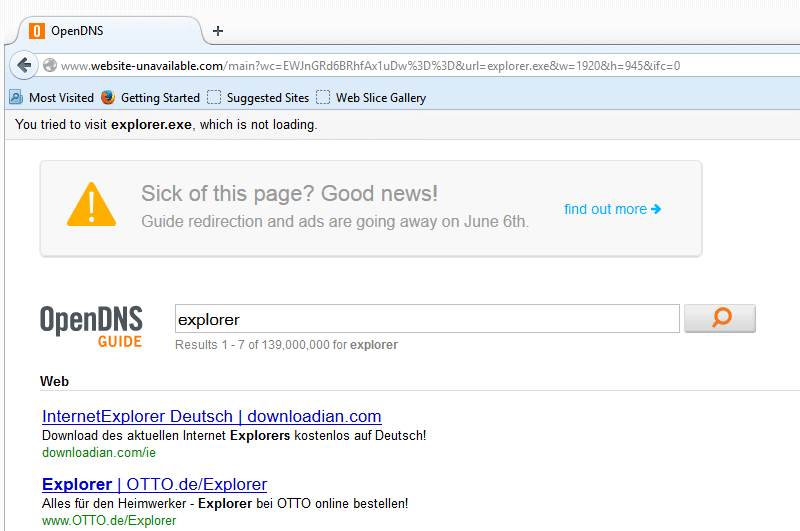
- #STOP SEEING OPENDNS UPDATER WINDOW INSTALL#
- #STOP SEEING OPENDNS UPDATER WINDOW FULL#
- #STOP SEEING OPENDNS UPDATER WINDOW PASSWORD#
- #STOP SEEING OPENDNS UPDATER WINDOW WINDOWS#
#STOP SEEING OPENDNS UPDATER WINDOW PASSWORD#
Configure post authenticating actions – Define actions that a device takes when its local admin account password expires.Passwords are stored using strong encryption.

#STOP SEEING OPENDNS UPDATER WINDOW WINDOWS#
Intune support for Windows LAPS includes the following capabilities: Intune's use of the CSP replaces the use of Legacy Microsoft LAPS or other LAPS management solutions, with CSP based taking precedence over other LAPS management sources. Intune LAPS policy manages the settings available from the Windows LAPS CSP. Managing LAPS with Intune can also help improve security for remote help desk scenarios and recover devices that are otherwise inaccessible. Use of Intune LAPS policies helps you protect Windows devices from attacks that are aimed at exploiting local user accounts like pass-the-hash or lateral-traversal attacks. You can also view details about the managed local admin accounts in the Intune Admin center, and manually rotate their account passwords outside of a scheduled rotation. Schedule rotation of those account passwords to help keep them safe.Back up a local admin account from devices to your Active Directory (AD) or Azure AD.Enforce password requirements for local admin accounts.You can use Microsoft Intune endpoint security policies for account protection to manage LAPS on devices that have enrolled with Intune. Windows devices include Windows Local Administrator Password Solution ( LAPS), a built-in solution to help manage local admin accounts. Securing this account is an important step in securing your organization.
#STOP SEEING OPENDNS UPDATER WINDOW FULL#
(Name of the network you set up in OpenDNS) <-Īnd configure your DNS as describe JE2Tom in his post.Every Windows machine has a built-in local administrator account that can’t be deleted, and which has full permissions to the device. # This option only Takes effect if the ddclient runs in daemon mode. # Set the time interval Between the updates of the dynamic DNS name in seconds. # If tis is changed to true, run_ipup Must Be Set to false. # Set to "true" if ddclient Should run in daemon mode This Might Be Useful, if You are using dial-on-demand. # Set to "true" if ddclient run Should Be Every time a new ppp connection is # Generated from debconf on Mon Aug 2 12:39:39 CEST 2010 Now we have to configure 2 files, open a terminal and type the following : sudo nano /etc/default/ddclient When it starts to ask for parameters just click next and next. If the command is repeated, the last line of the output should represent: SUCCESS: Home: skipped: IP address was already set to 72.30.35.10. When the above command is run for the first time, the last line of the output should represent: SUCCESS: updating Home: good: IP address set to 72.30.35.10 Test once (not as daemon): $ sudo ddclient -verbose -file /etc/nf The primary reference for this section is an OpenDNS support article. The last line is your network label as shown in OpenDNS Settings. Use sudo nano /etc/nf to configure as below: protocol=dyndns2 Given this file, upon a reboot, the ddclient process should start automatically start in daemon mode. # This option only takes effect if the ddclient runs in daemon mode. # Set the time interval between the updates of the dynamic DNS name in seconds. # If this is changed to true, run_ipup and run_dhclient must be set to false.

# Set to "true" if ddclient should run in daemon mode This might be useful, if you are using dial-on-demand. # Set to "true" if ddclient should be run every time a new ppp connection is # from package isc-dhcp-client) updates the systems IP address. # Set to "true" if ddclient should be run every time DHCP client ('dhclient' # generated from debconf on Sun Jun 24 00:08: Use sudo nano /etc/default/ddclient to configure as below: # Configuration for ddclient scripts The correctness of its configured values is not very important at this time, as they need to be reconfirmed and possibly changed later anyway.
#STOP SEEING OPENDNS UPDATER WINDOW INSTALL#
Install the updater: $ sudo apt install ddclient To limit the updates to a specific network, refer to this question. This answer integrates the two answers before it by hhlp and user268594. As of 2018, here are the steps to get the IP updater working.


 0 kommentar(er)
0 kommentar(er)
